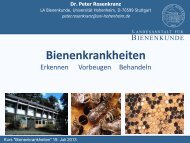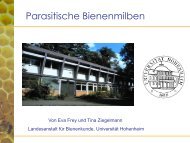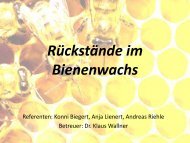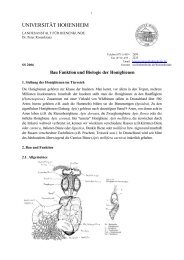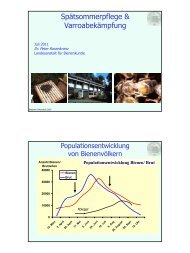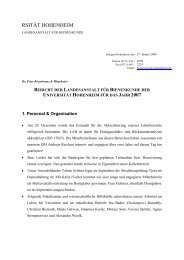Nosema ceranae in European honey bees - Landesanstalt für ...
Nosema ceranae in European honey bees - Landesanstalt für ...
Nosema ceranae in European honey bees - Landesanstalt für ...
You also want an ePaper? Increase the reach of your titles
YUMPU automatically turns print PDFs into web optimized ePapers that Google loves.
S76 I. Fries / Journal of Invertebrate Pathology 103 (2010) S73–S79<br />
5. Diagnosis and biology<br />
There is no specific outward sign of disease <strong>in</strong> <strong>bees</strong> <strong>in</strong>fected<br />
with N. apis, although the ventriculus of heavily <strong>in</strong>fected <strong>bees</strong><br />
may appear whitish and swollen (Fries, 1997). Similarly, there<br />
are no outward symptoms reported for N. <strong>ceranae</strong>. Thus, diagnosis<br />
requires light microscopy, or more sophisticated molecular methods.<br />
The spores of N. <strong>ceranae</strong> are slightly smaller than <strong>in</strong> N. apis,<br />
but the two species are nevertheless difficult to tell apart with certa<strong>in</strong>ty<br />
under a light microscope (Fig. 1; Fries et al., 2006a). Us<strong>in</strong>g<br />
transmission electron microscopy, the species can be separated<br />
based on the number of polar filament coils on that basis that N.<br />
<strong>ceranae</strong> always have fewer coils compared to N. apis (Fries et al.,<br />
1996; Chen et al., 2009) (Fig. 2). Several PCR based molecular techniques<br />
for the diagnosis and identification of N. apis and N. <strong>ceranae</strong><br />
have been described. Protocols for the PCR–RFLP method (Higes<br />
et al., 2006; Klee et al., 2007), a uniplex PCR us<strong>in</strong>g species specific<br />
primers (Chen et al., 2008) and a multiplex PCR for amplification of<br />
DNA from the two species simultaneously (Martín-Hernández<br />
et al., 2007) have been published. The latter methodology is accepted<br />
and recommended by The World Organisation for Animal<br />
Health (OIE Terrestrial Manual, 2008). Because mixed <strong>in</strong>fections<br />
of the two parasites are common <strong>in</strong> some areas (Paxton et al.,<br />
2007) the development of quantitative molecular tools is necessary<br />
to describe relative parasite prevalence.<br />
Colony level symptoms of dysentery may be aggravated by<br />
<strong>in</strong>fections of N. apis (Bailey, 1981) but this agent is not the primary<br />
cause of this condition (Bailey, 1967). Nevertheless, dysentery certa<strong>in</strong>ly<br />
aids the fecal–oral route of parasite transmission. For<br />
N. <strong>ceranae</strong> no specific colony level symptoms of <strong>in</strong>fection have been<br />
described. In Spa<strong>in</strong>, <strong>in</strong>fected colonies have been associated with<br />
gradual depopulation, higher autumn and w<strong>in</strong>ter colony death<br />
and a decrease <strong>in</strong> <strong>honey</strong> production (Higes et al., 2008a). Strik<strong>in</strong>gly,<br />
no dysentery is reported to be associated with <strong>in</strong>fections of<br />
N. <strong>ceranae</strong> (Faucon, 2005; Higes et al., 2008a). Whether this <strong>in</strong>dicates<br />
that the ma<strong>in</strong> transmission routes of N. <strong>ceranae</strong> are different<br />
from N. apis, where soiled comb is believed to be the primary<br />
Fig. 1. Spores of N. <strong>ceranae</strong> (A) are dist<strong>in</strong>ctly smaller than spores of N. apis (B).<br />
Nevertheless, they can be hard to dist<strong>in</strong>guish by light microscopy, <strong>in</strong> particular<br />
where mixed <strong>in</strong>fections occur. Bars = 5 lm. (From Fries et al. 2006a).<br />
Fig. 2. The <strong>in</strong>ternal structures of the diplokaryotic (D) N. <strong>ceranae</strong> (A) and N. apis (B)<br />
are similar. Notably, N. <strong>ceranae</strong> spores conta<strong>in</strong> fewer polar filamant (PF) coils<br />
compared to N. apis. Bars = 0.5 lm. (from Fries et al. 2006a).<br />
source of <strong>in</strong>fection (Bailey, 1955) rema<strong>in</strong>s to be <strong>in</strong>vestigated. Disease<br />
transmission through soiled comb is possible because N. apis<br />
spores may rema<strong>in</strong> viable <strong>in</strong> fecal deposits for more than a year<br />
(Bailey, 1962) whereas the effect of time on the viability of N. <strong>ceranae</strong><br />
spores <strong>in</strong> the hive environment is unknown. Nevertheless,<br />
even if freez<strong>in</strong>g significantly reduces N. <strong>ceranae</strong> viability (Fig. 3,<br />
Fries and Forsgren, 2009), the spores of this parasite do rema<strong>in</strong> viable<br />
for extended periods outside of <strong>bees</strong>, given that viable spores<br />
have been found <strong>in</strong> regurgitated pellets of the bee eat<strong>in</strong>g bird Merops<br />
apiaster (Higes et al., 2008b).<br />
The <strong>in</strong>tracellular development of N. <strong>ceranae</strong> <strong>in</strong> the ventricular<br />
cells appears to be similar to that of N. apis (Fries et al., 1996; Higes<br />
et al., 2007; Chen et al., 2009). The spores enter the bee through the<br />
food canal and germ<strong>in</strong>ate <strong>in</strong> the midgut where the epithelial cells<br />
become <strong>in</strong>fected. There is as yet no evidence for N. <strong>ceranae</strong> spores<br />
be<strong>in</strong>g produced <strong>in</strong> any other cell type than <strong>in</strong> the ventricular epithelial<br />
cells (Fries et al., 1996; Higes et al., 2009). However, us<strong>in</strong>g<br />
PCR, Chen et al. (2009) report on f<strong>in</strong>d<strong>in</strong>g N. <strong>ceranae</strong>-specific nucleic<br />
acid, not only <strong>in</strong> the ventricular epithelium, but also <strong>in</strong> the Malpighian<br />
tubules, hypopharyngeal glands, salivary glands and fat body<br />
cells. These data suggest that N. <strong>ceranae</strong> may not be cell specific,<br />
but it rema<strong>in</strong>s to be demonstrated whether the parasite can complete<br />
its life cycle outside of the ventricular cells. Us<strong>in</strong>g light<br />
microscopy, no spores of N. <strong>ceranae</strong> were found <strong>in</strong> any other tissue<br />
type <strong>in</strong> A. cerana when the parasite was first described (Fries et al.,<br />
1996). Nevertheless many microsporidian species <strong>in</strong>fect multiple<br />
tissues. As an example, <strong>Nosema</strong> bombi, a parasite of different bumble<br />
bee species, completes its life cycle not only <strong>in</strong> the ventricular<br />
cells, but also <strong>in</strong> the Malpighian tubules, fat body cells and even <strong>in</strong><br />
the bra<strong>in</strong> and nerve tissue cells (Fries et al., 2001).<br />
Follow<strong>in</strong>g a dose of 10,000 spores to <strong>bees</strong> kept at +30 °C, the<br />
growth rate of N. <strong>ceranae</strong> is similar to that of N. apis, but mature<br />
spores are produced a day or so later (Paxton et al., 2007). Both<br />
parasites reach approximately 30 million spores <strong>in</strong> the midgut<br />
after 10–12 days although <strong>bees</strong> may need to be kept longer to<br />
reach the maximum spore number <strong>in</strong> N. <strong>ceranae</strong> (Paxton et al.,<br />
2007). Martín-Hernández et al., 2009 reported different growth<br />
curves for both parasites at +33 °C with spores produced much faster<br />
<strong>in</strong> N. <strong>ceranae</strong>. However, they (Martín-Hernández et al., 2009)<br />
used a dose of 100,000 spores per bee and <strong>in</strong>vestigated the whole<br />
abdomen and not just the ventriculus. The discrepancy <strong>in</strong> growth



